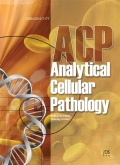Authors: Aubele, Michaela | Auer, Gert | Braselmann, Herbert | Nährig, Jörg | Zitzelsberger, Horst | Quintanilla‐Martinez, Leticia | Smida, Jan | Walch, Axel | Höfler, Heinz | Werner, Martin
Article Type:
Research Article
Abstract:
Multiple chromosomal imbalances have been identified in breast cancer using comparative genomic hybridization (CGH). Their association with the primary tumors' potential for building distant metastases is unknown. In this study we have investigated 39 invasive breast carcinomas with a mean follow‐up period of 99 months (max. 193 months) by CGH to determine the prognostic value of chromosomal gains and losses. The mean number of chromosomal imbalances per tumor was 6.5±0.7 (range 2 to 18). The most frequent alterations identified in more than 1/3 of cases were gains on chromosomes 11q13, 12q24, 16, 17, and 20q, and losses on 2q
…and 13q. A significantly different frequency of chromosomal aberrations (p≤0.05) was found between DNA‐diploid and non‐diploid tumors (gain on chromosome 17). Differences were also noted between tumors progressing to distant metastases within the period of follow‐up and those which do not (gains on 11q13 and 12q24; loss on 12q). Significant univariate correlations (p≤0.05) with the metastasis‐free survival of patients were found for lymph node status, the cytometrical determined DNA ploidy (diploid/non‐diploid) and anisokaryosis, and for DNA gains on 11q13, 12q24, 17, and 18p. An unexpected inverse correlation was found between clinical outcome and gains on 11q13 and 12q24. In multivariate analysis independent prognostic value, in addition to lymph node status, was found for chromosomal gains on 11q13, 12q24, 17 and 18p. Amplification on 20q, which did not correlate with metastasis‐free survival in a univariate analysis, showed weak prognostic significance in combination with the nodal status. The prognostic value of chromosomal alterations – some of them by inverse correlation – suggests an interaction and/or compensation of the involved amplified genes and their effects on the occurrence of distant metastases in breast cancer patients.
Show more
Keywords: CGH, prognosis, breast cancer, chromosomal imbalances, metastasis‐free survival
Citation: Analytical Cellular Pathology,
vol. 24, no. 2-3, pp. 77-87, 2002
Price: EUR 27.50





